Graphic by Jane Montalto
Jonathan Joestar is not going to win. Flames bellow around the muscular man in the boat’s engine room. In his arms, he holds the vampiric head of his adopted brother, Dio Brando, who mortally wounded Jonathan on his honeymoon. Dio has taken everything away from Jonathan — his father, his home and the friends made along his journey to defeat the vampire. And now, a future with his new wife, Erina Pendelton.
Nevertheless, Jonathan embraces him. In his final moments, Jonathan accepts his inevitable death and whispers to Erina to escape. Dio frantically begs Jonathan to reconsider, promising him immortality and to heal him. But it’s too late. Jonathan Joestar is dead. The ship explodes. The adventure has ended.
My eyes stung. It was 4 o’clock in the morning, and I was stunned. How could JoJo’s Bizarre Adventure continue now that JoJo was dead? As I scrambled through my brain wondering how the story could continue, a familiar tune played. When the episode ended, “Roundabout” by Yes introduced Joseph Joestar — the next hero — as a “To be continued” arrow dashed across the screen.
JoJo’s Bizarre Adventure began in 1987 with its first part, “Phantom Blood,” released in Shonen Jump Magazine, a popular manga anthology. Author Hirohiko Araki tested the bounds of his story in both style and story. To kill the main protagonist of a manga series was unheard of, yet for Araki, the risk made sense. Taking inspiration from John Steinbeck’s multigenerational tale, East of Eden, Jonathan’s death as a hero meant that not only would he be immortalized, but he would open the door for the story to continue with a new plot and a new protagonist, Joseph Joestar.
JoJo’s Bizarre Adventure is a saga of family and destiny. It tells the story of the Joestar family, a long-lasting lineage of strong-willed individuals who fight whatever fate throws at them. They fight vampires, a species of rock humanoids, a hand-loving serial killer who just wants a quiet life and even the 23rd president of the United States. There’s no question that the Joestar family has had some pretty bizarre adventures. Araki relishes in the bizarreness — suspending the reader’s disbelief to the point where it becomes completely acceptable to find ghostly manifestations of one’s soul named after Western rock music or fight Disney characters on the way to Orlando. Throughout the story, Araki riffs on the names of Western figures: Jonathan teams up with Robert E. O. Speedwagon (REO Speedwagon) and William Zeppeli (Led Zeppelin) to defeat vampire Dio Brando (Ronnie James Dio from Black Sabbath). Araki also alludes to numerous fashion illustrators such as Tony Viramontes, Antonio Lopez and Tetsuo Hara’s manga Fist of the North Star.
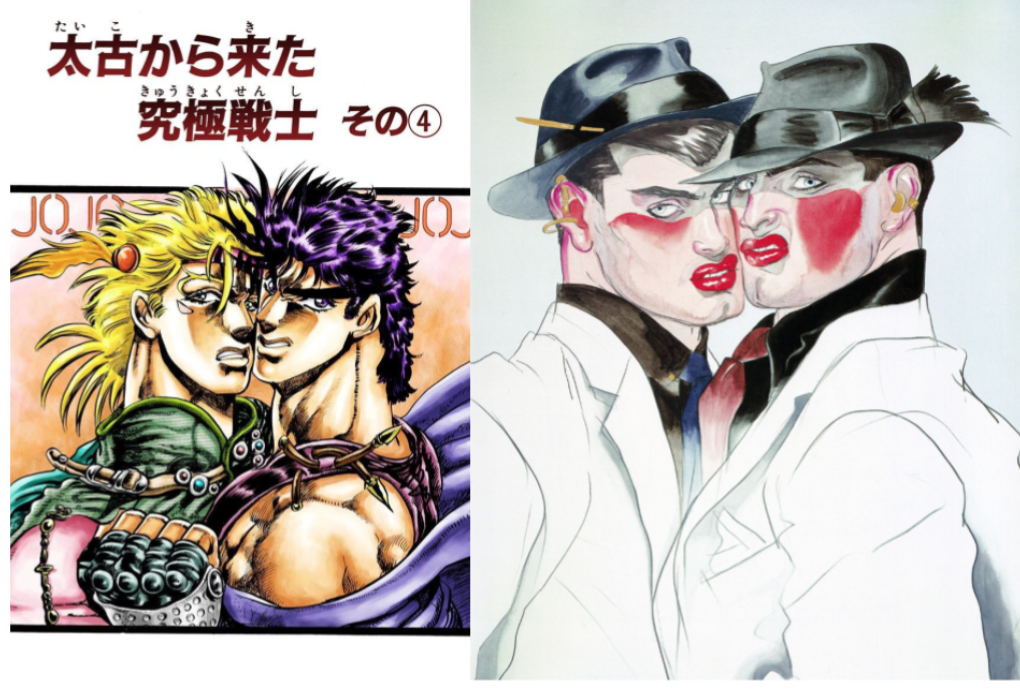
The metamorphosis of Araki’s art style and frequency of musical and art references grow alongside the manga. This process has been repeated throughout the series’ 35-year run, with a new member of the Joestar family traversing genres, the world, time and the universe itself in each new iteration. The story has nine parts, with the newest part, “The JoJolands,” released in February 2023. It is no wonder that over time, this manga has become a beloved work, with many fans praising Araki’s skill at building worlds and his meticulous attention to detail when weaving Western music and fashion elements into the story. On the flipside, JoJo’s Bizarre Adventure’s sheer bizarreness has allowed it to transcend internet spaces through references and meme-culture.
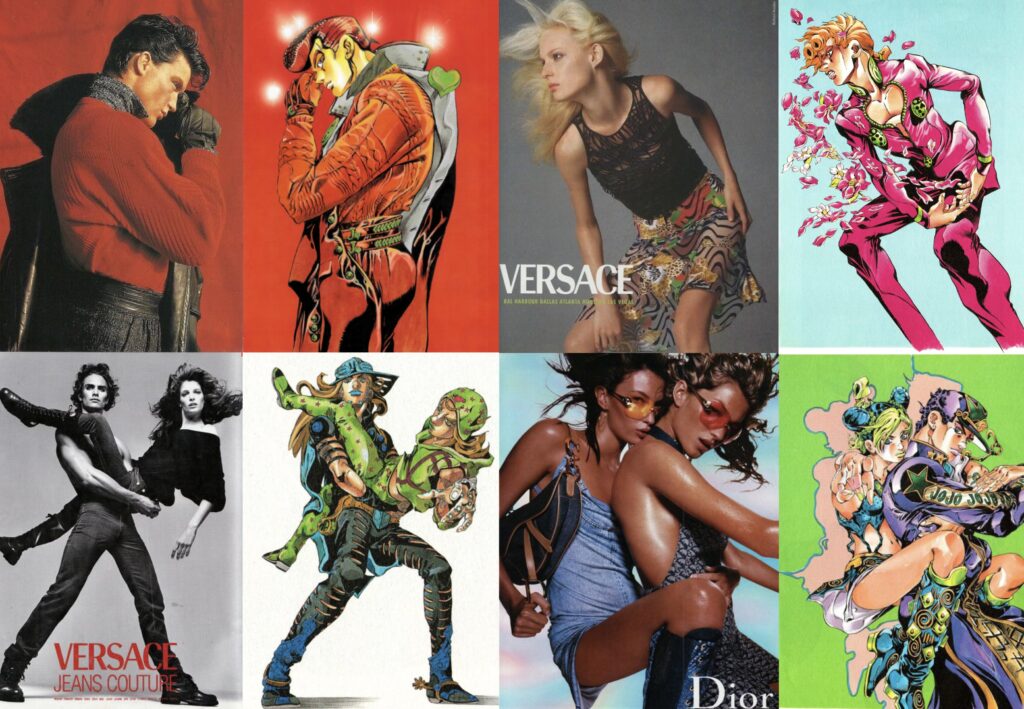
Before he began writing the series, Araki took a trip to Italy. It was there that he saw the lifesize marble statue of “Apollo and Daphne” sculpted by Gian Lorenzo Bernini in the 1620s. He was enamored by the twisting poses, which inspired him to focus more deeply on realistic shapes. As he drew, opened beside him were fashion magazines and sculpture books. The result was his own unique art style that was distinct from what was being published at the time.
“Because characters’ poses can reveal much about them, down to what emotions they are feeling, poses are an incredibly important element of drawing,” Araki explains in his 2017 book Manga in Theory and Practice: The Craft of Creating Manga.
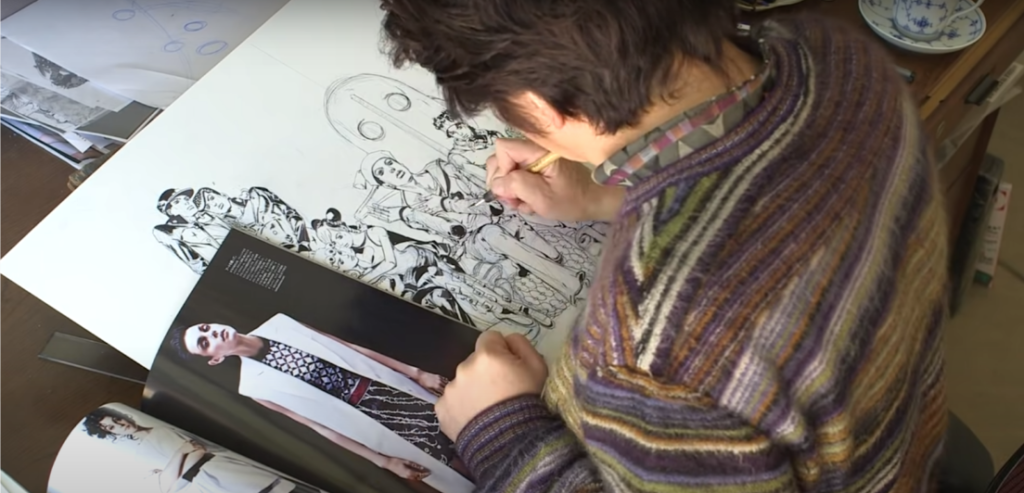
In an interview with Viz Media, Araki recognized the influence of what’s known as the “JoJo pose” — the exaggerated poses and stylized stances of the characters. “It’s heavily influenced by Rome, Roman sculptures and their poses,” he explained. “The modern-day fashion industry can also trace its roots back to the Romans. It’s really a universal thing.”
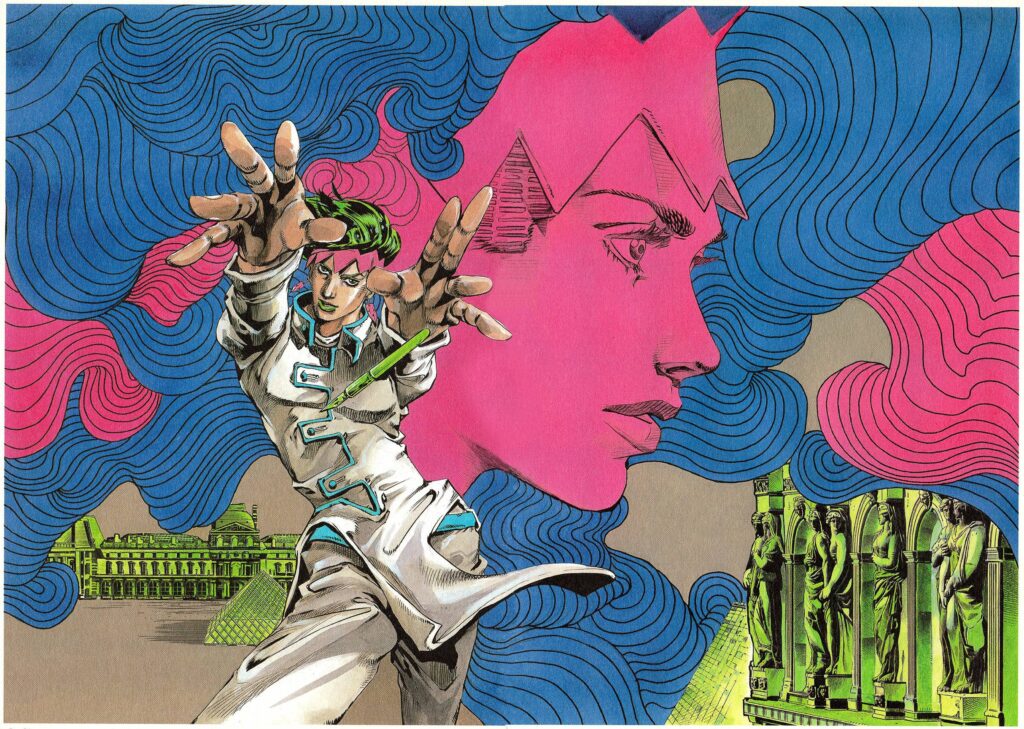
Across the world, JoJo’s Bizarre Adventure has been honored for its innovation in art and culture. In 2009, Hirohiko Araki became the first Japanese manga artist to be featured in the Louvre Museum in Paris. His original artwork, “Rohan at the Louvre,” was displayed among some of the greatest pieces of art in the world. The museums and masterpieces he once referenced in his work now honored him.
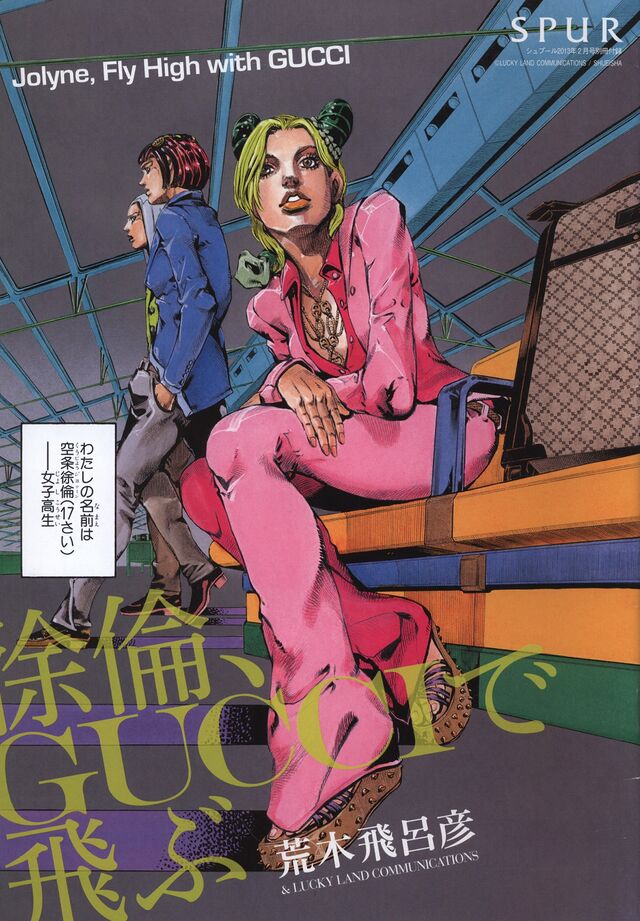
In addition to the intricate and unique poses his characters strike, what they wear is inspired heavily by luxury fashion brands such as Gucci and Versace. As Araki uses fashion magazines to guide his illustrations, he draws inspiration from what each model wears and creates eccentric outfits for the cast in the already bizarre story. Once referencing fashion magazines and couture shows, Gucci and Balenciaga have now featured Araki and his work in collaborations with his characters wearing runway looks. Some of his characters’ namesakes come from fashion brands such as Narciso Anasui, Enrico Pucci, Hermés and Emporio.
For the cosplay community, JoJo’s Bizarre Adventure presents a unique challenge: how to create and wear the unconventional costumes of the characters. Ky, also known as @apollo11_cos, is a cosplayer with more than 58,000 followers on TikTok. They have cosplayed more than 80 JoJo’s characters, including every character in “JoJolion,” the 8th part of JoJo’s Bizarre Adventure — and Ky’s favorite.
“I just do it because of my love of the series,” Ky explained. “And doing the makeup is just so fun because like, no other manga series has that unique style — just trying to figure out how to make myself look like I just walked out of the manga.” Ky has thrifted and hand-sewn many of their cosplays, crafting some in just a few days.
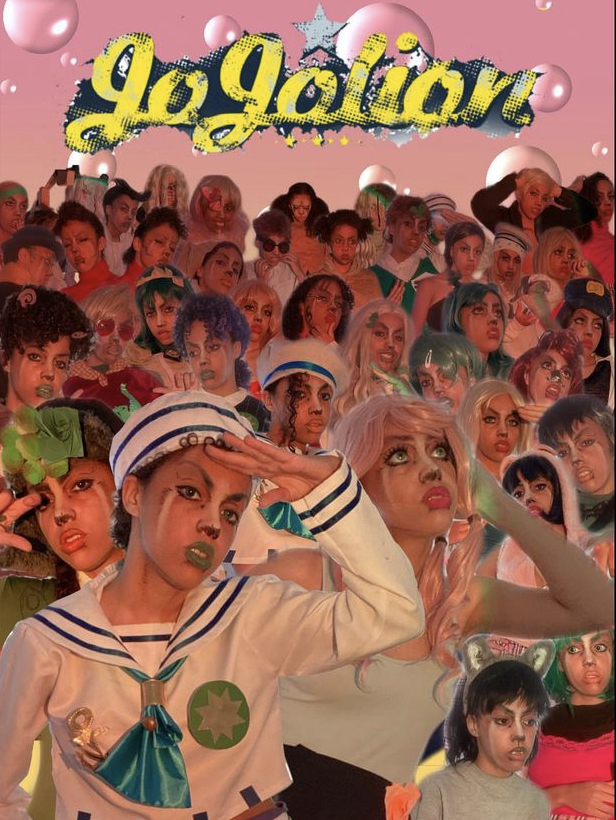
The Berklee music major began cosplaying during the COVID-19 pandemic and was introduced to JoJos through an insistent friend. Ky found the characters’ relatability and diversity in gender expression appealing and enjoyed the series’ connection to music.
“The main thing for me is the music references because I’ve been a musician, and now I’m going to college for music. So just being like, ‘Hey, wait. Esidisi is named after the band [ACDC].’ In JoJolion, a lot of the references are jazz standards, like Autumn Leaves, and last semester, I played that in my ensemble, and I already knew it from JoJolion.”
As the story progresses, these musical motifs become more and more glaring with the introduction of ghostly manifestations of the characters’ fighting spirits, known as Stands. In JoJo’s universe, they usually fight along with the cast while shouting song titles, artists, or albums as they attack. “Sticky Fingers,” “Soft and Wet” and “White Album” are just a few of the many names of stands that play major roles in the story. Sometimes the characters are even named for music artists and songs: Foo Fighters, Kars, Weather Report and Jolyne — for Dolly Parton’s “Jolene.” It may seem, well, bizarre, but for JoJo fans, this homage is a welcome part of the deep lore of JoJo’s Bizarre Adventure. With nods to Queen, ACDC, Wham!, Oingo Boingo, Prince, Pink Floyd, King Crimson, The Rolling Stones, Led Zeppelin, Sade, Lady Gaga and others, Araki dominates the art of referencing classic bands and fashion brands.
Japanese audiences relished the story for 25 years for its melodrama and craziness, but Western audiences weren’t truly exposed to the series until the animated version aired in 2012. It took the internet by storm for its absurdity and meme-ability.
What JoJo’s Bizarre Adventure did to the internet was create an inside joke — where every single thing in the universe can be drawn back to the story in the form of JoJo references.
While Araki took inspiration from art, music and fashion, fans in turn have sought references in the most esoteric ways. A steamroller? JoJo reference. The country of Italy? JoJo reference. DiGiorno Pizza? JoJo Reference. Jesus Christ? JoJo reference! All of these unsuspecting things are tied to JoJo’s Bizarre Adventure, and fans will let you know.
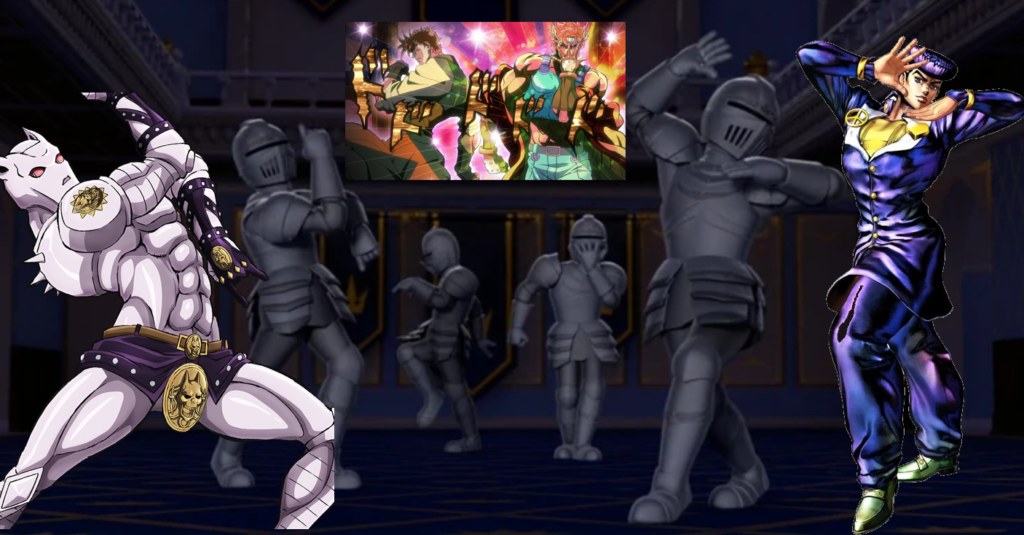
It becomes a scavenger hunt to find connections to the anime and manga out of anything and everything. In Paw Patrol, a children’s cartoon, fans noticed JoJo posing in the background. The TV show Family Guy referenced the “To Be Continued” meme, which stemmed from how each episode of JoJo’s Bizarre Adventure ends. Songs such as “JoJo Pose” by Apollo Fresh and “RN” by Joey Valence and Brae reference JoJo, with the former sparking a TikTok trend with thousands of videos replicating the iconic poses from the anime and the manga.
I used to make fun of JoJo fans in the library after school. They were street preachers, trying to convert those willing to listen to a bizarre faith. They showed me meme compilation videos, explained plot snippets without any context and even forced me to watch an episode. It was unrelenting, but the passion of the fans is something straight out of a cult — and I wanted to understand why.
After watching the first 60 episodes over a two-week school break, my brain was wired differently. I mumbled quotes and catchphrases under my breath. I began to pose in my room emulating the characters. My once normal life became filled with JoJo no matter where I went. I returned to school a different person — I was now a JoJo fan.
It is an exclusive club where JoJo fans unite and have long convoluted discussions about anything from the convoluted story. With so much to talk about, everyone’s answers are different and unique. Jeff Purirojejananon, a recent graduate at Stony Brook University, was once a stranger to me. We had mutual friends, so we sat eating lunch together on a club trip to New Orleans. When the topic of anime came up, I said my favorite was JoJo’s Bizarre Adventure. Jeff’s head snapped, turning to look at me. He whipped out his phone to reveal his Johnny Joestar lock screen, and we began blabbering about our favorite characters and parts of the story and our excitement about JoJo’s future. Like me, he once thought JoJo’s was cringeworthy.
“My first exposure to JoJo’s was a couple of years ago where my friend showed me the Dio vs. Jotaro fight, and I honestly thought it was cringe as hell,” he said, referring to the time when the cunning Jotaro Kujo stopped his heart mid-fight to convince Dio that he’d died. “Some years later, my friends were talking about JoJo parts and which one was their favorite, which got me into actually watching all of them.”
JoJo fans want to be seen. They want others to get a glimpse of the glory and insanity that is JoJo’s Bizarre Adventure. YouTube comment sections for music and bands referenced by Jojo are flooded with observations and jokes about the characters and storyline. With such a dedicated fan base, it did not take long for some artists to notice. English prog-rock band King Crimson posted about JoJos’s on their Facebook page. Michael Polnareff, a French musician and the namesake of the character Jean Pierre Polnareff, posted the character on Twitter to the elation of JoJo fans.
There is a method to this madness. While JoJo references everything, everything becomes a JoJo reference within its fandom. It’s a never-ending cycle of discovering a reference and seeing it played out in real life. I could be walking in the supermarket and stop in my tracks as “Walk Like an Egyptian” by the Bangles, the credit song for the third part “Stardust Crusaders,” plays over the loudspeaker. Someone could mention the Roman Colosseum and my brain replays the mafia battle that took place there in 2001 during the fifth part “Golden Wind.” I could be eating a gyro when I remember Gyro Zeppeli, a character from Araki’s seventh JoJo part called “Steel Ball Run.”
No matter how bizarre JoJo’s Bizarre Adventure gets, it deserves the love and attention it receives. Araki’s one-of-a-kind magnum opus is a testament to his love of art and culture. The infatuation by fans is warranted because in the same way that JoJo’s is a story of legacy, it is up to the fans to continue the legacy. Araki is currently writing the ninth part, “The JOJOLands,” and the anime still has two other parts to adapt for fans to enjoy. But even when JoJo’s Bizarre Adventure “ends,” the story won’t ever really be over — because if its fans know anything, it is this: Hirohiko Araki’s last words at the end of every episode are always, “To be continued.” The continuing love and passion fans have for this work can take them on adventures for life.

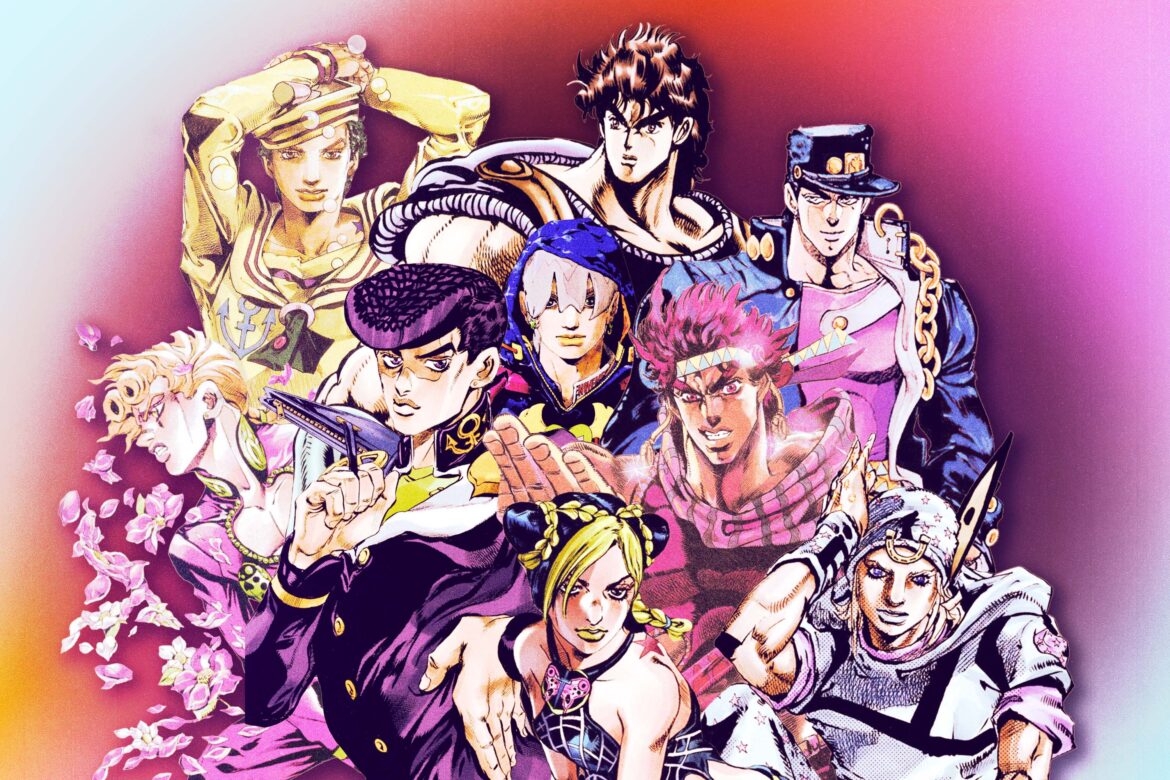


Comments are closed.